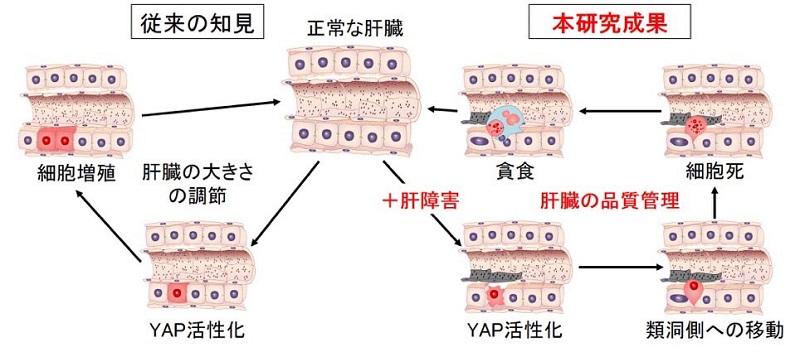In vivoにおいてYAPは損傷を受けたマウス肝細胞の運命を決定する
YAP determines the cell fate of injured mouse hepatocytes in vivo
2017年7月6日 Nature Communications 8 : 16017 doi: 10.1038/ncomms16017

老化細胞、形質転換細胞、損傷細胞の存在は、組織の機能を低下させたり、腫瘍形成につながったりすることがある。従って、生物はそのような細胞を排除する品質管理機構を進化させてきた。本論文では、マウス肝臓のin vivoモザイク解析を用いることで、損傷を受けた肝細胞でのYAP活性化(Hippo経路の不活化)により、損傷を受けた肝細胞が選択的に排除されることを示す。これらの損傷を受けた肝細胞は肝類洞内に移動後、アポトーシスを起こして、クッパー細胞に貪食される。対照的に、損傷を受けていない肝細胞でのYAP活性化は細胞増殖につながる。肝類洞の内皮細胞および肝細胞の両方を損傷するエタノールなどの細胞ストレスは、活性化YAPが存在すると細胞増殖から細胞移動/アポトーシスへと細胞運命を切り換える。本事象には細胞移動を調節するCDC42やRacの活性化が関与している。従って、YAPはストレスセンサーとして機能して、損傷を受けた細胞の排除を誘導し、組織や臓器の恒常性を維持していると考えられる。
Corresponding Author
The presence of senescent, transformed or damaged cells can impair tissue function or lead to tumorigenesis; therefore, organisms have evolved quality control mechanisms to eliminate them. Here, we show that YAP activation induced by inactivation of the Hippo pathway specifically in damaged hepatocytes promotes their selective elimination by using in vivo mosaic analysis in mouse liver. These damaged hepatocytes migrate into the hepatic sinusoids, undergo apoptosis and are engulfed by Kupffer cells. In contrast, YAP activation in undamaged hepatocytes leads to proliferation. Cellular stresses such as ethanol that damage both liver sinusoidal endothelial cells and hepatocytes switch cell fate from proliferation to migration/apoptosis in the presence of activated YAP. This involves the activation of CDC42 and Rac that regulate cell migration. Thus, we suggest that YAP acts as a stress sensor that induces elimination of injured cells to maintain tissue and organ homeostasis.

